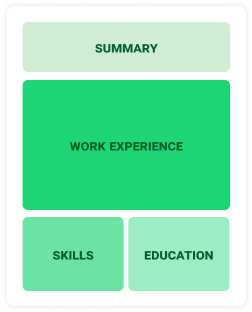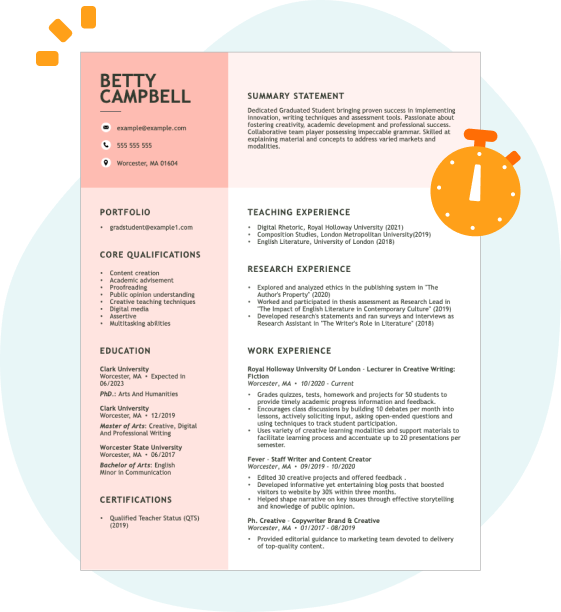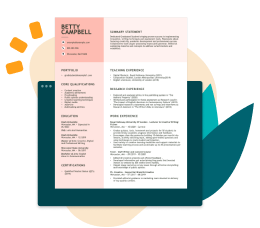Technical proficiencies such as algorithms, programming languages, and image processing techniques are hard skills critical for developing computer vision applications.
Popular Computer Vision Engineer Resume Examples
Discover our top computer vision engineer resume examples that emphasize critical skills such as algorithm development, image processing, and machine learning expertise. These resumes illustrate how to effectively showcase your accomplishments in this innovative field.
Looking to build your own impressive resume? Our Resume Builder offers user-friendly templates specifically designed for tech professionals, helping you make a lasting impression.
Entry-level computer vision engineer resume
This entry-level resume for a computer vision engineer effectively highlights the job seeker's technical skills and accomplishments in AI model development, along with their leadership experience in team settings. New professionals in this field should clearly demonstrate their project successes and relevant coursework to attract employers, even when facing limited practical experience.
Mid-career computer vision engineer resume
This resume effectively showcases qualifications through quantifiable achievements and leadership roles in computer vision projects. Clear progression from data analyst to engineer highlights the job seeker's capability to tackle complex challenges and drive innovation in technology.
Experienced computer vision engineer resume
This resume demonstrates the applicant's strong expertise as a computer vision engineer, highlighting specific achievements such as boosting image processing speed by 30% and improving accuracy by 15%. The clear formatting allows hiring managers to quickly assess qualifications and accomplishments.
Resume Template—Easy to Copy & Paste
Li Smith
Brookfield, WI 53008
(555)555-5555
Li.Smith@example.com
Professional Summary
Accomplished Computer Vision Engineer with 9 years of experience. Expertise in image processing, machine learning, and real-time systems. Proven track record of improving model accuracy and efficiency.
Work History
Computer Vision Engineer
VisionTech Solutions - Brookfield, WI
August 2022 - October 2025
- Developed custom algorithms, reducing error rates by 20%
- Led a team to design real-time object tracking systems
- Enhanced image processing speed by 30% using optimized methods
AI Research Scientist
InnovateAI Labs - Brookfield, WI
June 2018 - July 2022
- Conducted research on neural networks for image classification
- Improved model accuracy by 15% using advanced techniques
- Published 5 papers in top-tier AI conferences
Machine Learning Engineer
DataBrain Technologies - Milwaukee, WI
June 2016 - May 2018
- Developed ML models, increasing prediction accuracy by 25%
- Deployed scalable ML solutions for large datasets
- Collaborated with cross-functional teams on model integration
Languages
- French - Beginner (A1)
- Spanish - Intermediate (B1)
- Mandarin - Beginner (A1)
Skills
- Computer Vision
- Machine Learning
- Deep Learning
- Image Processing
- Neural Networks
- Python Programming
- TensorFlow
- OpenCV
Certifications
- Certified Computer Vision Professional - Institute of Electrical and Electronics Engineers (IEEE)
- TensorFlow Developer Certificate - Google
Education
Master of Science Computer Science
Massachusetts Institute of Technology Cambridge, Massachusetts
May 2016
Bachelor of Science Electrical Engineering and Computer Science
University of California, Berkeley Berkeley, California
May 2014
How to Write a Computer Vision Engineer Resume Summary
Your resume summary is the first impression you make on hiring managers, so it’s essential to present yourself effectively. As a computer vision engineer, focus on your technical skills and project experiences that showcase your expertise in image processing, machine learning, and algorithm development.
Highlight your skill in programming languages, frameworks, and tools relevant to computer vision. Employers are looking for applicants who can demonstrate innovation and problem-solving abilities in real-world applications.
To help you grasp what works well in this section, review the following examples of successful resume summaries:
Weak resume summary
I am a skilled computer vision engineer with several years of experience in the field. I am looking for a job where I can use my knowledge and skills to help the company succeed. A position that offers a good work-life balance and professional development opportunities is what I desire. I believe I can contribute positively to the team if given the chance.
- Lacks specific details about technical skills or projects, making it too vague
- Overuses personal language, which detracts from professionalism and clarity
- Concentrates on personal desires rather than clearly outlining what value the job seeker brings to potential employers
Strong resume summary
Innovative computer vision engineer with 6+ years of experience developing AI algorithms for image recognition and autonomous systems. Successfully improved object detection accuracy by 30% in a major project, improving system performance across multiple real-time applications. Proficient in Python, TensorFlow, and OpenCV, with a strong foundation in machine learning and deep learning frameworks.
- Begins with specific experience level and specialization in AI algorithm development
- Highlights a quantifiable achievement that shows technical skill and impact on system performance
- Lists relevant programming languages and tools essential for computer vision engineering roles
PRO TIP
Showcasing Your Work Experience
The work experience section is important for your resume as a computer vision engineer, containing the bulk of your content. Good resume templates always emphasize this section to highlight your relevant skills and experiences.
This section should be organized in reverse-chronological order, listing your previous positions. Use bullet points to clearly outline your achievements and contributions related to computer vision projects in each role.
To further guide you, we’ve prepared a couple of examples that illustrate effective work history entries for computer vision engineers. These examples will help clarify what stands out and what may fall short.
Computer Vision Engineer
Tech Innovations Inc. – San Francisco, CA
- Worked on computer vision projects.
- Collaborated with team members.
- Conducted experiments and tests.
- Assisted in software development.
- Lacks specific details about contributions to projects
- Bullet points are generic and do not highlight unique skills or achievements
- Fails to mention any measurable results or impact of the work
Computer Vision Engineer
Tech Innovations Inc. – San Francisco, CA
March 2020 - Current
- Developed and optimized computer vision algorithms for real-time image processing, improving accuracy by 30% over previous models.
- Led a team in deploying machine learning solutions that reduced processing time by 40%, improving overall system efficiency.
- Conducted extensive testing and validation of new features, resulting in a 50% decrease in user-reported errors.
- Uses powerful action verbs to clearly convey the engineer's contributions
- Incorporates quantifiable results to showcase effectiveness and improvements achieved
- Highlights relevant technical skills while illustrating practical applications within the role
While your resume summary and work experience are important, don’t overlook the importance of other sections. Each part contributes to presenting a complete picture of your skills and experiences. For in-depth advice on crafting an effective resume, explore our how to write a resume comprehensive guide.
Top Skills to Include on Your Resume
A strong skills section is essential for a computer vision engineer’s resume. It lets you showcase your qualifications and makes it easier for employers to quickly see your fit for the role.
For this position, focus on technical skills such as skill in Python, familiarity with TensorFlow and OpenCV, and experience with machine learning algorithms. Highlighting these tools will demonstrate your readiness for the challenges in computer vision projects.
Meanwhile, soft skills like creativity, problem-solving, and collaboration are essential for innovating solutions and working effectively within multidisciplinary teams to improve project outcomes.
Choosing the right resume skills is important as it helps align your qualifications with what employers expect. Many organizations use automated systems to screen applicants, ensuring only those with the necessary skills make it through.
To effectively tailor your resume, closely review job postings. They often highlight key skills that attract recruiters' attention and help you pass through the applicant tracking system (ATS) filters.
PRO TIP
10 skills that appear on successful computer vision engineer resumes
Improve your resume to attract potential employers by showcasing the essential skills in high demand for computer vision engineers. You can see these skills illustrated in resume examples, helping you apply with a polished professional profile.
Here are 10 key skills you should think about adding to your resume if they align with your expertise and job expectations:
Machine learning
Deep learning
Image processing
Computer programming (Python, C++)
Data analysis
Algorithm development
Mathematics and statistics
Problem-solving abilities
Attention to detail
Collaboration and teamwork
Based on analysis of 5,000+ engineering professional resumes from 2023-2024
Resume Format Examples
Selecting the right resume format is important for a computer vision engineer as it emphasizes key technical skills, relevant projects, and career advancements that align with industry demands.
Functional
Focuses on skills rather than previous jobs

Best for:
Recent graduates and career changers with up to two years of experience
Combination
Balances skills and work history equally

Best for:
Mid-career professionals eager to highlight their skills and growth potential
Chronological
Emphasizes work history in reverse order

Best for:
Experts driving innovative solutions in machine learning and image processing
Frequently Asked Questions
Should I include a cover letter with my computer vision engineer resume?
Absolutely. Including a cover letter can significantly improve your application by showcasing your qualifications and enthusiasm for the position. It allows you to connect your experiences directly to the job. For tips on how to write a cover letter, explore our detailed guide or use our Cover Letter Generator tool to simplify the process.
Can I use a resume if I’m applying internationally, or do I need a CV?
When applying for jobs internationally, a CV is often more appropriate than a resume. A CV provides a comprehensive overview of your academic and professional history. For guidance on crafting an effective CV, explore our tailored resources that offer insights into how to write a CV and delve into various CV examples to understand formatting and best practices.
What soft skills are important for computer vision engineers?
Soft skills like collaboration, problem-solving, and effective communication are essential for computer vision engineers. These interpersonal skills aid in teamwork with colleagues and help clearly convey complex ideas to stakeholders, ultimately driving successful project outcomes.
I’m transitioning from another field. How should I highlight my experience?
When applying for computer vision engineer roles, highlight your transferable skills like analytical thinking, creativity, and teamwork. Showcasing these abilities demonstrates your adaptability and potential to thrive in tech projects. Use concrete examples from past experiences to illustrate how these strengths align with key responsibilities in computer vision, making you a valuable job seeker even if you have limited direct experience.
How should I format a cover letter for a computer vision engineer job?
To format a cover letter, start with your details at the top, followed by a respectful greeting. Craft an engaging opening that connects to the computer vision engineer role. Highlight relevant experiences and skills in the body, ensuring alignment with the job description. Conclude with a strong closing statement that encourages further discussion about your candidacy.
How do I add my resume to LinkedIn?
To improve your resume's visibility on LinkedIn, add your resume to LinkedIn by uploading it to your profile. Highlight key projects in the "About" and "Experience" sections. This strategy helps recruiters and hiring managers quickly identify qualified computer vision engineers like you, increasing your chances of landing opportunities.







